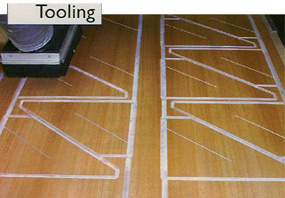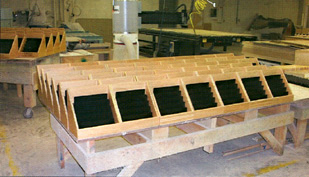| |
<
Back to Articles

Change in tooling aids shop
New York custom shop finds diamond-coated carbide solves tough machining
challenges
[From CabinetMaker®, January 2006.]

Demanding
cutting - Much of the work done by Paragon
Forming & Design of North Tonawanda, N. Y., involves high
production in prefinished plywood. Here, parts for CD racks
are cut on the VyTek CNC machine using diamond-coated tooling.
|
Paragon Forming & Design of North
Tonawanda. N.Y., is not your typical custom woodworking and
millwork operation. Oh sure. it does some custom built-ins,
but a big part of its business is specialized store fixtures
like display holders and listening stations for a line of music
CDs.
It also does countertops, modular countertop systems and both
refrigerated and non-refrigerated store fixtures.
Many of these projects include materials that are especially
tough on conventional tooling. Composite materials and particleboard
laminated with epoxy finishes, for example, can quickly wear
down traditional solid-carbide tools. |
Problems
with resharpening
Tim and Steve Prendergast, the brothers who founded Paragon in 1999,
were frustrated by the frequent resharpening cycle these materials
demanded when using traditional solid-carbide tooling.
'We were averaging 600 lineal feet before the tool needed to be
sharpened," says Steve Prendergast. .'Part of the problem we
came across was that every time we got the carbide sharpened, we
not only had to change the tool. we also had to recalibrate the
CNC to accommodate the smaller size created by the sharpening. This
all takes time and money."
On one project in particular, this problem became really apparent.
That on-going project involves fabricating and assembling display
holders and listening stations for a line of music CDs. The display
boxes are cut from pre-finished red oak plywood. Prendergast says
the finish used was very hard on the tooling in their VyTek CNC
router. For this project, since the customer paid per box and there
were orders of 1,000 boxes at a time, Paragon could make more money
if it could make the boxes in less time with fewer tool changes
and machine recalibrations.
Diamond
solution
Prendergast had seen advertisements for diamond tool coating
in trade journals, but he had not seriously considered using
the coating because he was afraid of the cost. Then he was contacted
by a local company, Diamond Tool Coating Inc., that offered
multilayer nanocrystalline CVD diamond coating for carbide tools.
DTC's vice president Paul Otto gave Prendergast a sample
tool to experiment with. Otto didn't hear from Prendergast for
six months,
when the tool finally gave out, and Prendergast was ready to
order more.
"We found that, although the initial cost of diamond tooling
is two to three times that of carbide tools, the increase in
lineal footage as well as the lack of downtime from changing
the carbide tooling makes the investment well worthwhile in
our application," says Prendergast. "And we don't
have to worry about the logistics of sending the tools out to
be sharpened, which includes the cost of purchasing several
extra tools and keeping track of when they would be back in
service." |

Not
all commercial - While Paragon's
work emphasizes commercial store fixtures such as grocery
displays, bank teller lines and solid surface countertops,
it also does residential millwork projects like this library
built-in. |
Comparing
costs
To make his decision on diamond-coated tooling, Prendergast made
a cost comparison for a 1/2inch down-shear bit. Initial cost of
the diamond-coated tool was $130, compared to $60 for the carbide
tool. But the diamond-coated tool produced 4,000 lineal feet of
cutting. The carbide tool needed sharpening after 600 lineal feet.
Prendergast estimated that sharpening the solid-carbide tool five
times cost $75 for the actual sharpenings, plus an additional $5O
in lost time from changing and recalibrating the machine (10 minutes
lost per change). With these costs figured in, the total cost of
the solid carbide tool was $185, and the total lineal footage produced
by the carbide tool was still only 3,000 feet. The solid-carbide
tool therefore cost $0.061 per foot, while the diamond coated tool
cost only $0.033.
Why
it works
According to Roger Bollier, president of Diamond Tool Coating, "The
advantage of crystalline-diamond coatings for carbide cutting tools
is that they combine the hardness of natural diamond with the strength
and relative fracture toughness of carbide. Diamond is a super-hard
material that resists abrasive wear and is virtually impervious
to corrosion when machining abrasive nonferrous metals, graphite,
plastics, wood and composite materials."
The crystalline diamond is grown onto the surface of an indexable
insert or round tool using a chemical vapor deposition process.
The hard diamond coating protects the carbide tool from chipping
when the tool contacts hard particles.
For
many materials
Prendergast quickly discovered the advantage of using diamond-coated
tooling wasn't limited to plywood. "We now use the diamond
tooling for cutting other materials, such as flake board, melamine
board, as well as solid surface," he says. "The diamond
tool leaves a nice, smooth, clean finish. The guys in my shop love
it."
He says prefinished plywoods are where he's gotten the best results,
adding that a single tool used to dado plywood is believed to have
produced 12,000 lineal feet of cutting. He says the advantages are
not so great on melamine, but it's still a big improvement over
a conventional carbide bit.
On solid surface material, Prendergast doesn't do the same kind
of long runs that he does in plywood, so he hasn't made a direct
comparison of the longevity of the diamond bits there. But he says
the real advantage in solid surface is cut quality. "It's a
really nice cut." he says. "It goes through solid surface
like it's butter. It's worth it because of cut quality."

Thousands
at a time - When
Paragon gets orders for
these CD racks, the jobs involve 1,000 boxes at a time. |
Matching
tooling to the shop
Paragon is a production-oriented shop with 16 employees working
in 35,000 square feet. Most machining is done on a VyTek CNC
router. They also use an SCM beam saw, an SCM sliding table
saw and an SCM edgebander. There is also Norwood thermoforming
equipment.
Prendergast says the diamond coated tooling makes sense for
their operation, but he says it may not be so cost effective
for every shop. "If you're cutting a lot, doing high production,
then you should try it," he says. "It also saves time
in calibration. When the bit is done, it's done, but it holds
calibration until then. For hand routers, it's not worth it."
|
|






